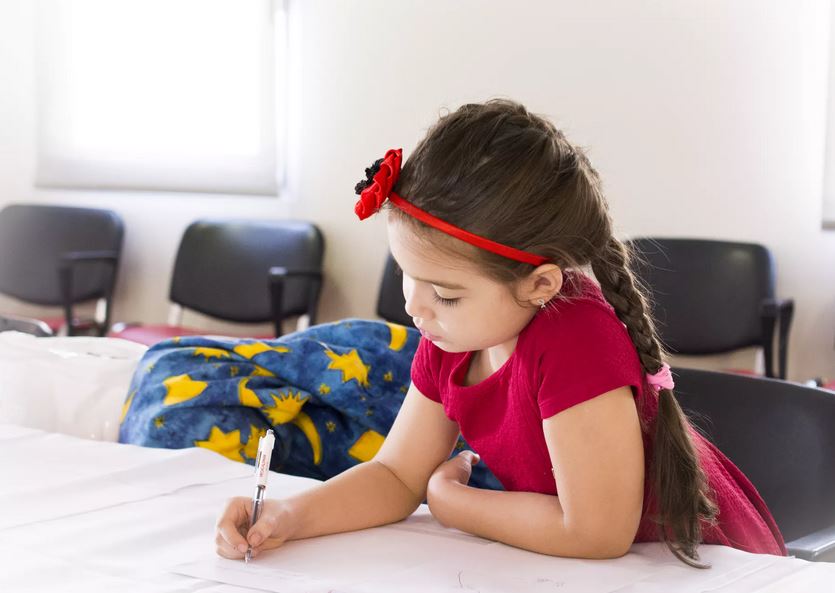Mindful Monday | Morning exercise, short breaks from sitting lower high blood pressure
An Australian study was published linking morning exercise and short walking breaks throughout the day to blood pressure control.
Society today calls for an increase in sitting for longer periods of time. Prolonged sitting can lead to higher blood pressure and increased blood pressure can lead to cardiovascular disease.
Australian scientists believe adding three-minute walking breaks throughout the day can help regulate blood pressure. Although it is known that exercise and short breaks can help lower blood pressure, scientists studied the benefits of combining the two.

“They recruited 67 men and women who were between 60 and 74 years old and overweight or obese. About 4 in 10 participants also had high blood pressure. Every participant completed three different day-long tests in random order, each separated by a minimum of six days. Researchers measured heart rate, blood pressure, blood sugar, and other blood markers during each test condition. “
During one test, participants sat for 8 hours straight and another they sat for an hour then walked for 30 minutes then went back to sitting for 6.5 hours. However, the last test participants sat for an hour then walked for 30 minutes, then sat back down but got up every 30 minutes for a 3-minute walking break.
The participants showed lower blood pressure throughout the day if any exercise was involved. “The biggest reduction was seen when people did the 30-minute treadmill exercise in the morning and took 3-minute walking breaks throughout the day – although the additional benefit of the walking breaks was seen only among women.”

Scientists were surprised that only women showed the benefits of lower blood pressure through the short 3 minute walking breaks. This finding leads researchers to believe there is a difference in blood pressure response and it could be affected by gender and epinephrine levels.
“We recognize that exercise is good, and we now have the awareness that prolonged sitting can increase blood pressure,” Bhammar told Reuters Health in a phone interview. “Now we need to build breaks into our routines as a default so we’re not sitting for four hours at a time.”
To learn more – Morning exercise, short breaks from sitting lower high blood pressure – Reuters
Sign up for Diabetes Blog Bytes – we post one daily Blog Byte from Monday to Friday. And of course, Tuesday is our Question of the Week. It’s Informative and FREE! Sign up below!
[yikes-mailchimp form=”1″]Free Resource Friday | Mindfulness & Compassion for Diabetes Educators
Join Heather Nielsen, MA, LPC, CHWC in this free webinar, as she walks you through hands-on strategies to incorporate mindfulness and compassion into our daily lives and professional practice.
This insightful webinar helps show how mindfulness and compassion can positively affect personal and professional relationships.
You can find additional resources and further reading on her webinar here.
Sign up for Diabetes Blog Bytes – we post one daily Blog Byte from Monday to Friday. And of course, Tuesday is our Question of the Week. It’s Informative and FREE! Sign up below!
[yikes-mailchimp form=”1″]One in five deaths worldwide linked to unhealthy diet
In 2017, a study found that 11 million deaths worldwide were linked to poor diet. The research demonstrated that too much sugar, salt, and processed meats can contribute to diabetes, cancer and cardiovascular disease.
Although there is still debate on the “ideal diet” a recent study recommended people double their intake of fruits, vegetables, and legumes and halve their intake of meat and sugar.
The study reviewed the diets of over 195 countries. “Consumption of healthier foods such as nuts and seeds, milk and whole grains was on average too low, and people consumed too many sugary drinks and too much processed meat and salt. This led to one in five deaths in 2017 being linked to unhealthy diets. “
A study from The Global Burden of Disease, from 1990 to 2017 found that an unhealthy diet was responsible for more deaths than any other health factor worldwide.
“The study found people ate only 12 percent of the recommended amount of nuts and seeds – an average intake of 3 grams a day, compared with the recommended 21 g – and drank more than 10 times the recommended amount of sugary drinks. Diets high in sugar, salt and bad fats are known risk factors for heart disease, stroke, diabetes and many types of cancer.”
The global diet also lacked in consumption of whole grains and doubled the recommended intake of processed meats.
As health care professionals we want to promote a healthy lifestyle and help encourage our community whenever we can. We have created a Plant-Based Eating Resource page and the “Joy of Six” sugar campaign to provide resources for healthy eating. We also invite you to join our Diabetes Education Course September 4-6, 2019, where nutrition expert Dana Armstrong discusses the importance of improving global and individual through diet.
The Joy of Six Campaign Materials
Diabetes Education Course September 4-6, 2019,
To learn more: One in five deaths worldwide linked to unhealthy diet – Reuters
Sign up for Diabetes Blog Bytes – we post one daily Blog Byte from Monday to Friday. And of course, Tuesday is our Question of the Week. It’s Informative and FREE! Sign up below!
[yikes-mailchimp form=”1″]App for Remotely Managing Hypertension Effective in Type 2
A new study shows a positive outcome for people with type 2 diabetes and utilizing a smartphone application to monitor blood pressure.
The study gave a Bluetooth-connected blood pressure monitoring device to 276 people with elevated BP for 6 weeks. After the device read their BP, the participants were sent their results along with helpful tips, and a reminder to take their medications.

During the study, there was also education provided to all participants with a goal to help lower BP ratings.
“Participants who had the highest blood pressure at baseline were the most likely in multivariable modeling to see reductions in both systolic and diastolic pressure by the end of the study.”
Researchers believe that using the app helped participants not only become more aware of their blood pressure regulation, but also fostered positive medication adherence and lifestyle changes.
To learn more: Smartphone App for Remotely Managing Hypertension Effective in Type 2 – Endocrinology Advisor
Sign up for Diabetes Blog Bytes – we post one daily Blog Byte from Monday to Friday. And of course, Tuesday is our Question of the Week. It’s Informative and FREE! Sign up below!
[yikes-mailchimp form=”1″]Is Weight Stigma a Barrier to Effective Education? | July Newsletter
July Newsletter Now Available!

Most of us aren’t even aware that weight bias is embedded in our everyday medical language, in scientific papers, and in our client interactions. But with awareness, we start hearing and seeing this bias all around us and realize that change is needed.
In our July Newsletter, we explore weight bias language and provide some examples and fixes. Plus, we invite you to apply for our diabetes education scholarship and highlight the approval for a GLP-1 RA for pediatrics with type 2 diabetes.
July Newsletter Topics
- What is weight bias and how do we fix it.
- You are invited to apply for our Diabetes Educator Course Scholarship in San Diego, CA – Deadline July 22, 2019.
- Approval for a GLP-1RA for pediatrics with type 2 diabetes.
- Digital PocketCards Updated.
- Bring a Friend – $80 discount on the Diabetes Educator Course.
Click here to read our newsletter
Sign up for Diabetes Blog Bytes – we post one daily Blog Byte from Monday to Friday. And of course, Tuesday is our Question of the Week. It’s Informative and FREE! Sign up below!
[yikes-mailchimp form=”1″]How to Avoid Stigmatizing Kids with Obesity

Sensitive and appropriate language is a real struggle for health care providers when trying to tackle the topic of weight. National Public Radio (NPR) published an article on How Doctors Can Stop Stigmatizing and Start Helping Kids with Obesity, which recognized that many primary care providers may feel awkward in the limited window of time they have to sensitively and effectively find healthy solutions for those struggling with excess weight.
With this struggle, it makes sense that an American Diabetes Association (ADA) study has found many providers, accidentally or otherwise, show weight bias. See, Overcoming Weight Bias in the Management of Patients with Diabetes and Obesity.
The same study explains that weight bias can manifest as an attitude that “patients with obesity are lazy, lack self-control and willpower, personally to blame for their weight, noncompliant with treatment, and deserving targets of derogatory humor.” This is why, NPR explains, “the American Medical Association passed a resolution in 2017 designed to teach health care providers to use ‘people-first language.” Some examples are to avoid the words overweight, obese, or extremely obese and instead use phrases like excess weight or elevated body mass index. And instead of saying “obese patient”, use terms like person with obesity, person with elevated BMI or person with excess weight.
Eliminating weight bias from our written and spoken language is challenging. It requires honest reflection and an open mind. Our whole team at Diabetes Education Services is dedicated to using person centered language. Yet, we are still learning and working on transitioning all of our content to be respectful and free of weight bias.
Language matters and health care professionals are in such an important position to effect change in people’s lives. For more tips on how you can change how you talk about diabetes and weight, see our webinar on Language & Diabetes.
Evaluate your Weight Bias –Harvard’s Project Implicit
Project Implicit is a non-profit organization that provides international collaboration between researchers interested in implicit social cognition – the thoughts and feelings outside of conscious awareness and control. The goal of the organization is to educate the public about hidden biases and to provide a “virtual laboratory” for collecting data on the Internet.
For more information on weight bias and stigma, read our July Newsletter.
Sign up for Diabetes Blog Bytes – we post one daily Blog Byte from Monday to Friday. And of course, Tuesday is our Question of the Week. It’s Informative and FREE! Sign up below!
[yikes-mailchimp form=”1″]Free Resource Friday | Updated Preparing For the CDCES Exam 2019

Join us live Today @ 11:30 a.m. PST!
New Preparing for the CDCES Exam Webinar has been updated to reflect the changes to the content outline as of July 1, 2019. Join us live by clicking the link below to register!
Receive notification for On Demand Viewing
Can’t join us live? No problem, all of our content is recorded and will be available within hours of the broadcast ending. Register here and we will send you a link to the recorded version later today.
Coach Beverly’s Best Recommended Bundle
Need more to prepare? We recommend our most successful bundle to save money and help you prepare: CDCES Prep Bundle + 5th Edition AADE Review Guide (book ships next Wednesday, courses are immediate)
Sign up for Diabetes Blog Bytes – we post one daily Blog Byte from Monday to Friday. And of course, Tuesday is our Question of the Week. It’s Informative and FREE! Sign up below!
[yikes-mailchimp form=”1″]23andMe launches a predisposition test for Type 2 diabetes
This past March, 23andMe, a personal genomics and biotechnology company announced their latest reporting technology, a test that determines a person’s predisposition to Type 2 diabetes.
The test itself is to help people identify what level of risk they may have in developing Type 2. However, it is not meant to imply that the report actually diagnoses a person with Type 2.

The company has recently partnered with Lark Health, a platform that uses artificial intelligence to help people manage chronic disease. The idea is that 23andMe will help identify the risk of chronic disease through the examination of genetic data. Once you are aware of the risk level, you would then use Lark Health to change lifestyle habits.
The release of this test is significant, as it is the first test that utilizes the data collected to examine risk for disease. “For a company like 23andMe, increasing the number of tests they offer adds a lot of value, and can have a snowball effect: the more data they collect, the more tests they can develop and the more tests they offer the more data they can collect (since new tests will drive new users to the service).”
The rates of Type 2 diabetes continues to increase, affecting 1 in 10 Americans and costing more than $327 billion dollars a year. By informing consumers of their risk of Type 2, 23andMe hopes to help increase prevention efforts.
The announcement of the new risk test was met with some push-back, stating that screening tests are already in place, the difficult part is encouraging someone to actually change their habits and lifestyle to better their health.
23andMe hopes that their evidence-based approach with the widespread qualitative diagnosis of pre-diabetes will help people take the diagnoses more seriously.
With diabetes expected to affect half the population, 23andMe is hoping “When customers learn about their genetic likelihood of developing Type 2 diabetes, we believe there is an opportunity to motivate them to change their lifestyle and ultimately to help them prevent the disease.”
To Learn More: 23andMe launches predisposition test for Type 2 diabetes – mobihealthnews
Sign up for Diabetes Blog Bytes – we post one daily Blog Byte from Monday to Friday. And of course, Tuesday is our Question of the Week. It’s Informative and FREE! Sign up below!
[yikes-mailchimp form=”1″]








